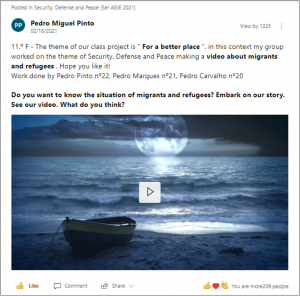Author: Luís Nunes, Agrupamento de Escolas José Estêvão teacher. Revised by Glória Leite and Fernando Delgado, Agrupamento de Escolas José Estêvão
Schools always be aware and keep their eyes on the future. AEJE- Agrupamento de Escolas José Estêvão community usually uses an internal social network in which students’ works, activities and projects are shown and disseminated This internal network has 3971 members, and it is composed of students, teachers and parents.
Members of this social network must authenticate themselves with ID to access it, and insurance that all the members are working in a safe and close environment. This social network has an RGPD in which students and teachers can share images, videos, and documents in the same way we do inside the classroom.
The social internal network YAMMER was the best response found in 2020 to the need to share and present the works, and projects when we were dealing with online/distance teaching and learning during the first pandemic lockdown. This option was taken regarding this social network allowing a safe environment for sharing and interaction amongst the different school communities.
With the return to face-to-face teaching, the internal social network maintained its structuring status in sharing and social interaction in a hybrid learning environment. The great majority of activities, projects and works done by students are shared through a post on the Yammer social network.
Based on the educational project of the José Estêvão Schools Group, whose main thrust is the development of human capital and the involvement of the educational community in the goals outlined by the Sustainable Development Goals recommended by the United Nations to implement the educational project, the social network is organized into thematic communities according to the 17 SDGs.
The works shared by the students are published in the communities according to their thematic scope. Students are encouraged by teachers to publish their own work, from the 1st cycle to secondary education. They are encouraged to produce publications rich in digital content and in accordance with the rules of participation in the context of social networks.
An example of a publication made by a student, as a result of teamwork, may well illustrate the dynamics of interaction that is obtained with the school’s social network.

A schoolwork publication teamwork done by secondary students – February 2021
The teamwork, under the theme “For a better world”, addressing the condition of migrants, was published in the “Security, Defense and Peace” community. The publication was seen by 1225 members of the AEJE social network. The same received social feedback through 210 reactions and 27 comments.
This use places the student at the centre of learning, allowing an evaluation of results through social feedback and allowing the identification and reinforcement of good practices in the school context. We must recognize that, if it weren’t for the school’s social network, no student would be able to see their work recognized by more than a thousand elements of the educational community and generate reactions from more than two hundred of these elements.
In fact, no student in the future will work in isolation and without being involved in collaborative dynamics and networking. It is on this horizon of the future that we develop our educational project. An inclusive school values interpersonal relationships and teamwork. A school that assumes digital contexts with school spaces for interaction and learning.